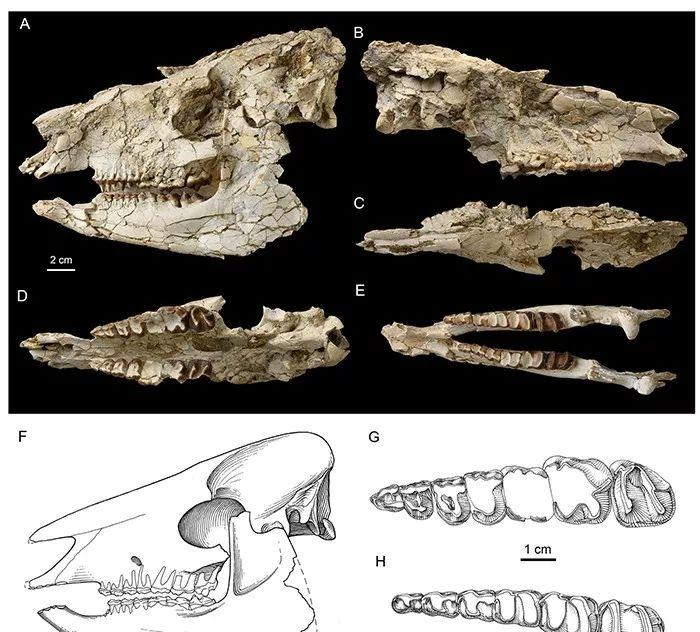Deperetellidae is a taxon endemic to Asia in the tapir superfamily , found mainly in the Eocene strata of China , Mongolia , Kyrgyzstan and Burma. Dai tapir is a very specific class of tapir superfamily, with its upper molars in a "U" shape, which differs from the distinct posterior cusp in the present tapir family; in the late Ephemerocene progressive taxa, its premolars have been completely molarized; the posterior skull bones show good running features; and the tooth enamel has a combination of Schlesh's chiaros, which are similar to members of the early rhinoceros superfamily. Although more fossils of Dai's tapir have been found in the past, the specimens are mostly incomplete upper and lower jaws and some posterior skull bones, so the origin and phylogenetic relationship of this group has been controversial.
Recently, Bai Bin, Wang Yuanqing, Mao Fangyuan and Zhang Zhaoqun of the Institute of Vertebrate Paleontology and Paleoanthropology of the Chinese Academy of Sciences, in collaboration with Meng Jin, a researcher at the American Museum of Natural History, published a study on the fossils of the original Dai tapir skull and carpal bone from the bottom of the Ashantou Formation in the Erlian Basin of Inner Mongolia, from the early Ephemerocene, and discussed the enamel microstructure of their teeth and the pattern of molarization of the premolar molars.
Through a detailed description and comparison of skull and carpal bone materials, the researchers believe that it represents the most primitive Known Dai tapir and named a new genus: Irenolophus qii (Figure 1), dedicated to Mr. Zitao, who has done a lot of field and research work in the Erlian Basin. Researchers also believe that the Dai tapir, like the tapir family, is likely to have evolved from a primitive marsh tapir. This is mainly manifested in the fact that both the Tapir and the early Marsh tapir have a degenerate posterior tip that squeezes towards the side of the tongue, the inferior molar tends to be bispinal, and the anterior jaw is not degenerated, in contact with the nasal bone. According to the analysis of the microstructure of the lower molar enamel, the dipterocarpellae has a vertical scholastic band and a pronounced midsectch in the glaze column (Figure 2). In addition, the anterior molar dendria pattern of Dai's tapir also shows very unique features (Figure 3). In the process of evolution of most odd-hoofeds, the premolars have a gradual molarization process, that is, the premolars in the early taxa are usually relatively simple in structure, and the later gradual complexity is close to the morphology of the molars. This molarization process is usually achieved by protruding a ridge backward from the primary tip and thus differentiating into sub-cuspes (e.g., marsh tapirs, tapirs, and most other odd-hoofed species); in Dai's tapir, the molarization process is formed through the gradual separation of the anterior and primary cusp; this pattern was previously only seen in P3 of the Eocene equine and P2 of the tapir Metaphalyachyus. So the progressive taxon Ofeti tapirs, Deperetella, and tapiraus premolars in tapirs, are both fully molarized, but their corresponding lateral tip of the tongue and the two transverse ridges are not homologous structures. The anterior molars of amphibian rhinoceros are formed by the separation of the primary and posterior cusp. These three models illustrate that the molarization of the premolars of different taxa pseudogluga has different mechanisms, and the causes and effects of these different mechanisms still need further research work.
The research was funded by the Pilot Strategy Project of the Chinese Academy of Sciences (XDB26000000), the National Natural Science Foundation of China (41672014, 41572021, 41472003), the State Key Laboratory of Modern Paleontology and Stratigraphy Open Project Fund (163103), and the Youth Innovation Promotion Association of the Chinese Academy of Sciences.

Fig. 1: Irenolophus qii gen at the bottom of the Ashantou Formation, a proto-Taupeli tapa of the Late Eliocene. et sp. nov.) Skull and teeth (Sketch: Xu Yong)
Fig. 2: Microstructure of the enamel under the Irenolophus
Figure 3: Evolution of the gradual molarization of the premolars of the main taxa of the tapir superfamily, and the three modes of molarization of the premolars of the odd-hoofed species
Source: Institute of Vertebrate Paleontology and Paleoanthropology, Chinese Academy of Sciences
Warm tips: Recently, the WeChat public account information flow has been revised. Each user can set up read-free subscription numbers, which will be displayed in the form of large cards. Therefore, if you don't want to miss the "Voice of the Chinese Academy of Sciences" article, you must do the following: